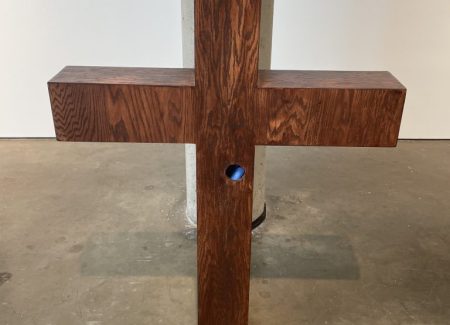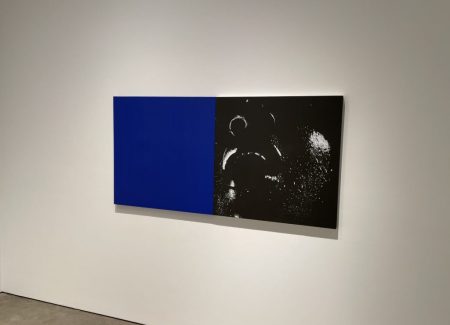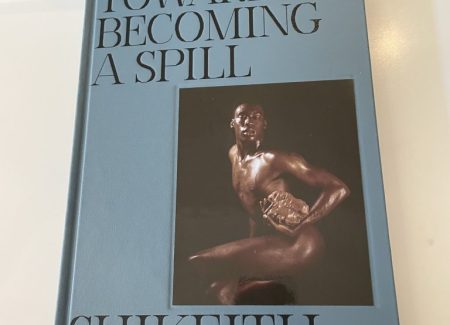JTF (just the facts): A total of 15 black-and-white and color photographs, framed in black and unmatted, and hung against white and grey walls in the East and West gallery spaces, and the smaller viewing room and jewel box areas in between. The show also includes a smaller number of sculptural works and paintings.
The following works are included in the show:
- 12 archival inkjet prints, 2019, 2020, 2021, 2022, sized 30×24, 36×30, 38×30, 50×33, 49×60 inches, in editions of 5+2AP
- 1 archival inkjet print diptych, 2019, sized 37×30 and 24×16 inches, in an edition of 5+2AP
- 1 archival inkjet print diptych, 2021, each panel sized 37×32 inches, in an edition of 5+2AP
- 1 archival inkjet print and found photographs, 2020, sized roughly 20×19 inches overall, in an edition of 5+2AP
- 1 five-channel video and plywood, 2022, sized roughly 60x43x8 inches, unique
- 1 silkscreen on wood panel, 2022, sized 48×36 inches, unique
- 1 glass, breath, ceramic, plywood, 2022, sized roughly 38x42x21 inches, unique
- 1 silkscreen on wood panel/oil on wood panel diptych, 2022, sized 36×36 each panel, unique
- 1 blown glass, breath, dreams, 2020, sized 14x9x7, unique
- 1 glass, breath, ecstasy, 2021, sized roughly 12x7x7, unique
(Installation shots below.)
A monograph of this body of work was recently published by Aperture (here). (Cover shot below.)
Comments/Context: The charged aesthetics of desire never really go out of style as a compelling photographic subject. Across the history of the medium, artists have repeatedly spent time exploring and defining the possible representations of desire, and while in the past that desire was most often seen through the eyes of a straight white male, desire of course comes in many forms – straight and gay, male and female, old and young, bodily and spiritual, and countless in-betweens, hybrids, and combinations of any binary we might try to propose or define. That we restlessly keep trying to express the nuances of desire (and its many emotional relatives) through art says that we still haven’t found ways to capture all the human complexity that we find wrapped up in these powerful instincts, urges, and feelings.
Black queer desire is one distinctive version of desire that has often languished in the photographic shadows. Back in the 1980s, pioneering Black photographers like Alvin Baltrop, Rotimi Fani-Kayode, Lyle Ashton Harris, and others began to more fully explore the photographic aesthetics and possibilities of Black queer desire, and more recently, artists like John Edmonds, Paul Mpagi Sepuya, and D’Angelo Lovell Williams have taken up the banner and continued to expand the visual vocabulary used to tell these stories. This introductory gallery show from the artist known as Shikeith adds another name (and another individual perspective) to the contemporary list.
Like Fani-Kayode’s, Shikeith’s images tilt toward the enveloping richness of darkness, where desire simmers in the sultry heat. In Shikeith’s case, that heat has seemingly been turned up a notch or two, giving bodies a sheen of shimmering sweat or slippery dripping wetness; in one case, this aesthetic edges toward the oiled-up beefcake stylizations of Bob Mizer, but more often, it offers a tactile sense of warmth and energy, like tingling physicality, exhausted and satisfied.
This consistent sweatiness then bridges to a larger theme of water, which Shikeith uses in ritualistic poses that evoke baptism, cleansing, and even weeping. In “Feeling the Spirit in the Dark”, water is poured from a head-shaped glass vessel, dousing the model’s head and chest with seeming ecstatic refreshment and renewal. In other works, water droplets cover the extended body of man as hands reach down as if to bless or in cleansing prayer, and “Prince” licks his lips, the sweat that covers his body licked off with a satisfied air.
Shikeith’s engagement with religious motifs feels profound and meaningful, much in the way that Robert Mapplethorpe wrestled with his Catholicism in his early work. The symbol of the cross shows up as a small necklace around Prince’s neck and in a larger wooden sculpture populated with small video clips, and other ritualistic or religious poses pop up everywhere when we start to look closely: the straight backed pose of an altar boy holding a candle, a reference to man being created from clay in another pose, hands shown in prayer, hands reverently laid atop a bible (and decorated with more explicit candid nudes), a man hidden behind a confessional screen, and several men in states of quiet ecstasy or grace, with eyes closed or mouths open. Each of these images feels like an assertion of acceptance, or a re-negotiation between Shikeith’s identity and his sense of religion.
While most of the images in this show are darkly shadowed, a few of the works introduce a bright blue as a compositional feature. Most literally, this connects back to the water theme found across many of the pictures, but it also references the haint blue used in the South to ward off spirits and ghosts. Several works play with this idea, with a disembodied blue arm embracing a defenseless man in ecstasy, a doubled multiple exposure portrait with two faces, and an image of a man sleeping with a ghostly form snuggled up behind him. And in one of Shikeith’s sculptural works, blue glass orbs hover around a glass crib, providing protection from unseen spirits. Between the religious allusions and the ghostly motifs, it’s clear that the men in Shikeith’s portraits have a complex and layered relationship with their spirituality.
Seen as one integrated artistic statement, this show offers a sophisticated melange of interlocked ideas, where various forms of protection provide the space for ecstatic personal expression. And while there are plenty of nude Black bodies in this show, masculinity doesn’t feel like the central axis of exploration here (as we are often led to believe must be the case for a Black queer male artist); variation in the expressions of masculinity is more taken as a given, one part of a larger sense of self that being investigated, tested, and celebrated. Like many of his contemporaries, Shikeith is carving out a space for possibilities, using a multi-faceted approach to open many doors at once.
Collector’s POV: The works in this show priced as follows. The photographs range from $6000 to $20000, based on size, number of panels, and place in the edition. The sculptural works range from $6000 to $35000, while the paintings range from $10000 to $15000. Shikeith’s work has little secondary market history at this point, so gallery retail likely remains the best option for those collectors interested in following up.




















